|
Rhine Kanuen - Part II |

|
Be sure to read Rhine
Kanuen Part I
There came a Sunday in August when the
wife, a little fed up with me moping around on the
edge of madness from keeping track of two little girls
every day and trying to put a book together, said
OK, it is nice today and so you are going to take
your boat and go for a trip on the river. (She’s
a good wife).
So I went around and gathered up all the all the
bits and pieces of my folding
canoe while Valerie fed the girls and
gathered all the bits and pieces of the going out
equipment pack for the girls, and we both rode herd
on the two little tornados as they continued their
ceaseless quest to find something that a day before
had been out of reach to eat or dismantle or use to
hammer their sister or something else fragile.
Despite all their help, we found ourselves a couple
of hours later at Bad Honnef, a small resort village
about 35 miles upstream on the Rhine River from Cologne,
where we live. We found a little park next to a boat
ramp and set to putting the folding canoe together.
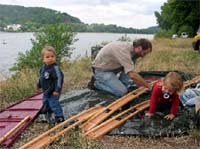 |
Maia
(L) and Rachel help their papa lose nuts
and bolts in the grass.
(click
images to enlarge) |
|
When I was building the canoe, I tried
as much as possible to use sliding bolts and other
bits of DIY store hardware to make it assemble as
quickly as possible, but there were a lot of places
where I just had to use bolts. On the bench in the
shop, it all went together pretty quickly, but in
practice it is a little disappointing -- a little
over an hour from pieces to boat.
As I was wrestling with two little octopuses over
screwdrivers and whatnot, a guy asked me if those
were my paddles floating away on the Rhine. I bought
a stainless ferrule from Duckworks to join the double
paddles, and found some 30 mm (1-1/4 inch) hardwood
dowels to make the shafts, but it turned out that
the wood was more like 29 mm and so to tighten things
up, I have been putting ferrule ends of the paddle
in the water to swell. This was the first try with
the new double paddle, and it worked really well.
But I learned that even if you put a head-sized rock
on the paddle blades when you stick the handles in
the water, the wake from a passing container barge
will still rip them loose. I was tighening the last
bolt in the nose of the boat when a guy stuck his
head out of an RV next to us and asked “Are
those your paddles floating away on the river?”
So there I was, an hour from home, the boat 3/4 built,
and literally up a creek. Mercifully, just as I was
stripping off my clothes to go for a swim, another
big boat came along and the wake pushed the paddle-halves
back to shore.
| Almost done
with the frame -- 1 hour |
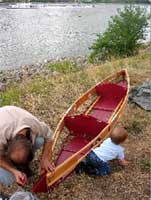
|
|
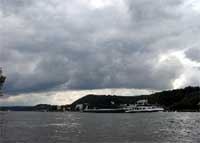 |
Afloat
at last, and just as the weather was starting
to get nice.
|
|
Finally though, we managed to get everything together
and I got on the water around noon as the clouds were
gathering toward the south for what looked like it
could be a real dinger of a thunderstorm. Bad Honnef
is a nice little town, and the area around it is about
as rich in German history as any place in the country.
Just across the river, I could see “Rolland’s
Bogen” (Rolland's Arch or Bow) the last remaining
bit of Burg Rolland's Eck (Castle Rolland's Corner).
The castle was originally built in the 12th century,
but the name comes from the hero of “The Song
of Rolland” a much older story, traditional
to both France and Germany, of the hero Rolland, a
sort of Lancelot to Charlemagne’s King Arthur
but without the adultery. He was betrayed by a compatriot
into a trap during a campaign against the Saracens
and died at the battle of Roncevaux Pass on August
15, 778. Interestingly he was not killed by the 100,000
Saracens that surrounded the Frankish rearguard of
20,000 warriors, he won that battle, but by a cerebral
haemorrhage brought on by blowing his magical horn,
Olifant, too loudly after reinforcements for the Saracens
arrived.
What exactly the remains of a 12th century door have
to do with a guy who popped a vessel in southern France
300 years earlier is something of a mystery, but anyway
it makes for a good story.
Just above and to my right, as I drift down the river
and realise after a long and awkward search, that
I have forgotten a cork screw, lies another ruined
castle, Drachenfels (Dragon’s Cave). It is perched
on top of a mountain, and the mountain is covered
with grape vines, and I brought a bottle of a nice
red German Dornfelder to commune with the landscape
and hoped that it would allow me to hear the Rhine
Maidens singing. There is always something, isn’t
there.
The other legendary hero of Germany is Seigfried,
the hero of the Niebelungenlied, a group of legends
and stories that date back to the 5th or 6th century.
It is all a cracking good yarn of Dark Ages bedhopping,
seduction, betrayal, revenge, senseless violence,
and copious amounts of banqueting which always included
copious amounts of red wine...
| In filling
in some of the gaps in my memory of the
story of Siegfried, I stumbled across this
cool engraving by Matthaus Merian in the
early 1600s. I took a photo, but this is
much nicer. |
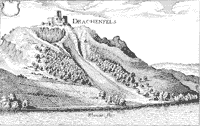
|
|
In any case, Drachenfels is the place where Seigfried
slays the dragon Fafnir in his cave. He then bathes
in the dragon’s blood under a linden tree to
make himself invulnerable but, as these things always
seem to go, a leaf falls from the tree and sticks
to his back, and that place remains vulnerable. Richard
Wagner in his Ring Cycle of operas, adds a nice bit
in that while bathing, Seigfried tastes the blood
and suddenly realises he can understand the song of
the birds. After his bath, he gathers up Fafnir’s
legendary treasure and wanders off to further renown,
adventures in an Icelandic Amazon queen’s bedroom
with the help of an invisible cloak and quaffing lots
of Rhine wine from Arabian unicorn horns, until one
day he is betrayed and stabbed in the back -- guess
where.
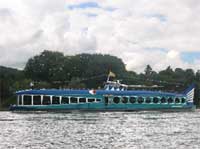 |
This very
traditional river boat, named Moby Dick,
is a disco that cruises up and down the
river around Bonn.
|
|
I spied a small port tucked in behind a peninsula
and decided to have a look and munch a few bratwursts
for lunch. I also hoped to spot some picnickers who
might have a corkscrew, but no luck there, there were
just a couple of refugees from a Motley Crue concert
fishing for carp.
After the bratwursts, I decided to open the bottle
of wine using a tried and true college method of dealing
with the problem. One gets a screwdriver and drives
the cork down into the bottle. One cannot then put
the cork back into the neck, but I have had worse
problems, I figured. So I tried it, but the cork was
apparently a long one, and the bottle was unusually
full, so the cork went in as far as the top of the
wine and stopped. I asked myself what Seigfried would
do, and gave the screwdriver another good whack. The
results were startling, if not in retrospect unexpected:
FWISH, the compressed air in the bottle drove a cone-shaped
fountain of atomized wine out of the bottle, covering
me and everything in the boat.
While I was working on it, I had drifted over near
a bank where the Motley Crue was fishing. They apparently
had been watching with interest and sympathy because
they hailed me as I was mopping the wine off my face
and glasses. When my vision cleared I saw that they
were laughing and holding up a bottle of wine and
a corkscrew. They helpfully suggested that if there
was no more wine in my bottle, I could drink with
them. I have done a lot of carp fishing in my day,
and met a lot of carp fishermen, and in my experience,
when fishing for carp, one drinks beer, but then I
am from Ohio. One might think this doubly true of
German carp fishermen, but apparently not in the Rhineland
wine areas.
| A traditional
Rhine fishing boat |
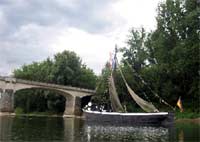
|
|
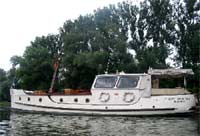 |
I’ve
seen this beautiful old yacht a number
of times on the river, It turns out she
was built in 1925 in Cologne.
|
|
| A traditional
river barge, converted to a yacht. |
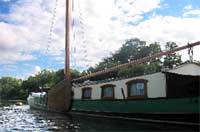
|
|
It turned out that despite the soaking I got, there
was a good bit of wine left in my bottle so I asked
about their luck (none) gave them a good “Proust”
and headed out of the harbor, as I still had something
over 30 miles to go before dark.
On an ordinary river, I would never have tried 35
miles in a half day, but the Rhine moves right along,
going a couple of miles an hour even out of the main
current which can hit something like 4 knots in places.
So even with a late start, I figured that I could
do it if I worked a bit. After leaving the harbor,
the surrounding hills rapidly flattened out, and the
river trip sort of flattened out too. There weren’t
any more ruined castles, no more nice little towns,
just the canalized Rhine with very little in the way
of backwaters or tributaries to explore. No animals,
no birds, except crows, seagulls and the very occasional
cormorant. Any day on any river is a treat, but I
think that next time I will head higher up the river
and spend a day or three in the wine country with
Siegfried and Roland and that crew.
A couple of hours into the trip, a humdinger of a
thunderstorm passed overhead. I don’t think
I caught the worst of it, but it blew pretty hard
and there were some real pyrotechnics. I pulled over
into a little cove. In the end it passed over pretty
quickly and there was no lightning close by so I just
sat it out and let the rain wash the wine off of me.
The day was not overly hot, but I had been sipping
on the water bottles and sipping on the wine over
the last four or five hours of paddling, and both
were gone. I only had another five miles or so to
go, and I figured it wasn’t worth pulling over
and hunting up an open kiosk in one of the small towns
here and there along the river, and I was pressed
for time. But by the time I got to the outskirts of
Colonge, my tongue was sticking to the roof of my
mouth, and I was getting pretty hungry.
Just then I heard the unmistakable sounds of Schlager
music -- the sort of German folk/popular music of
the last generation. Imagine songs of buxom but perfidious
blonds sung to the tune of a football team’s
fight song played on guitar, bass and drums and you
are in the neighborhood. My younger German friends
are pretty scathing about it, but to me Schlager means
one thing -- a street festival where they sell glasses
of cool local beer and bratwursts slathered in mustard.
At that moment, no siren’s song could have had
a stronger pull on me. I rounded a bend, and wonder
of wonders, there was a festival right on the river.
I pulled out of the current, headed for a small pebbly
beach and staggered up the stone embankment and there
it all was -- band, beer wagon and grill. I must have
been in worse shape than I thought, because when I
got to the wagon, the woman asked me what I wanted
and, tongue cemented to roof of mouth, and panting
I said something like adfahonvoarhv. Luckily for me,
the guy working the wagon had apparently noticed the
way my wake left a container barge pitching wildly
out in the channel, the acrobatic leap from the canoe
as it landed, the way I cleared the levee in a single
bound, and the beeline I made toward the beer sign,
and handed me a beer.
Then it was off to the bratwurst tent, and then back
to the beer tent. Then back to the bratwurst tent
and one more stop at the beer tent. The Koelsh beer
is a really delightful light lager, but out of some
perverse old tradition it is traditionally served
in glasses that hold about 4 oz. So to have what the
rest of the world considers “a beer” one
has to order three of them. But after the third bratwurst
and third beer, I finally felt more-or-less rehydrated
and fed, and hopped back in the canoe for the last
pull through the city.
| Getting close
to sunset as I hit the outskirts of Cologne |
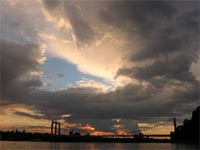
|
|
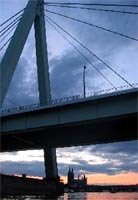 |
Severins
Bridge and the Cathedral
|
|
| The Hohenzollern
Bridge and the Cathedral |
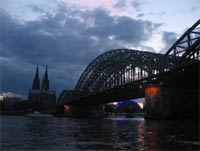
|
|
Just in time really. The sun was going down. Because
it was Sunday evening, there was no traffic on the
river, and it was easy to stick to the shallows near
the bank more or less the whole way, but just on general
principals it is a dodgy business to be canoeing in
the dark. The trip through the city was incandescent
though. A spectacular sunset, the beauty of the city
itself in the dusk, and the novel feeling of being
alone on the great river combined to make it something
worth remembering.

Original articles by Brian Anderson:
Features edited by Brian Anderson:
|